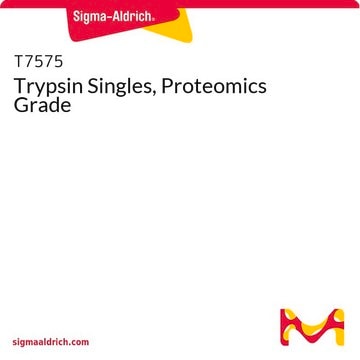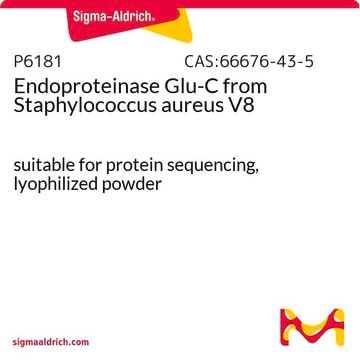General description
LysargiNase is a metalloproteinase found in the thermophilic archaea Methanosarcina acetivorans. It specifically cleaves before lysine and arginine residues in proteins. This cleavage results in peptides with molecular weights similar to tryptic peptides, but with N-terminal lysine or arginine residues that can be fragmented with b ion-dominated spectra. This can improve protein C-terminal peptide identification and several arginine rich phosphosite assignments. Unlike with trypsin, LysargiNase cleavage also occurs at methylated lysine and arginine, allowing detection of these epigenetic modifications.
LysargiNase is suitable for peptide or protein digestion in solution or in gel.
Application
LysargiNase is suitable for peptide or protein digestion in solution or in gel.
LysargiNase is suitable for peptide or protein digestion in solution or in gel. It is active under a variety of solvent conditions including 5 mM TCEP, 5% methanol, 5% acetonitrile, 0.8 M urea, 0.1% RapiGest, 1% deoxycholate, 0.2% SDS and 1% NP-40. It is active up to 55°C at pH 6 – 9. LysargiNase is reversibly inhibited by 1, 10-phenanthroline, EDTA and other calcium and zinc chelating agents. For peptide or protein digestion, a ratio of between 1:100 to 1:20 (w/w) enzyme:substrate is recommended.
Components
Each vial contains 20 µg LysargiNase, prepared by recombinant expression in E. coli and lyophilized from buffer.
Physical form
Each vial contains 20 µg LysargiNase, prepared by recombinant expression in E. coli and lyophilized from buffer. Upon reconstitution in 20 µL water, the enzyme is in 50 mM HEPES, 5 mM CaCl2, pH 7.5.
Storage and Stability
Store the lyophilized product at -20°C for up to 2 years. After reconstitution, the unused material can be stored in the freezer in aliquots. Avoid repeated freeze thaw cycles.
Other Notes
Concentration: Please refer to lot specific datasheet.
Disclaimer
Unless otherwise stated in our catalog or other company documentation accompanying the product(s), our products are intended for research use only and are not to be used for any other purpose, which includes but is not limited to, unauthorized commercial uses, in vitro diagnostic uses, ex vivo or in vivo therapeutic uses or any type of consumption or application to humans or animals.








